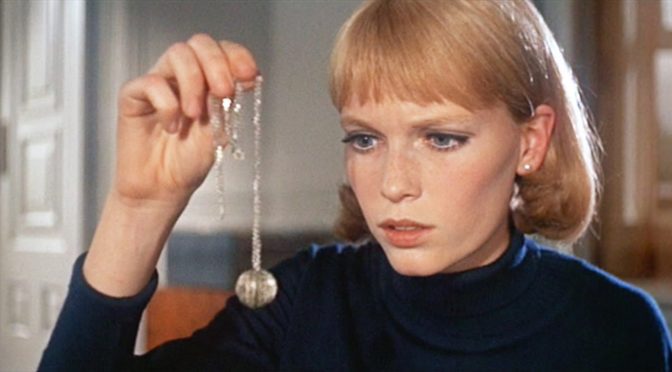“They use blood in their rituals!”
Rosemary’s Baby is unsettling, yes; at times it’s quite scary, but I wouldn’t go so far as to call it a horror film. Like our last entry The Orphanage it concerns itself with the fears and concerns of motherhood; it embraces and condemns the male gaze; it’s deeply feminist – but at it’s heart Rosemary’s Baby is a conspiracy thriller. This kitchen-sink approach to storytelling shouldn’t work, and it wouldn’t, were it not for the sure-handed direction of Roman Polanski.
We follow the titular character, Rosemary Woodhouse, played by Mia Farrow in a stunning performance that is equal parts vulnerability, determination, and warmth (also, she looks fucking gorgeous here; truly one of the 21st century’s great beauties); the only downside to Farrow’s performance is the weird Maude Lebowski accent she uses for a character who’s supposed to be from Omaha. She’s married to Guy (John Cassavetes, considered the father of independent film; his son Nick would go on to direct The Notebook), an ambitious but unsuccessful actor. They move into a luxurious apartment at the Branford, a building with an unseemly past (“They called it Black Branford,” their friend Hutch cautions them at one point). They become fast friends with their upstairs neighbors, Minnie and Roman Castavet (Ruth Gordon, who won an Oscar for her role, and Sidney Blackmer).
All the elements of a straightforward horror film are here: mysterious old neighbors, unexplainable deaths, even a creepy lullaby over the gorgeous opening shot of New York (I think Rosemary’s Baby invented this trope). But Polanski isn’t interested in making a straightforward horror film, probably because he isn’t adapting work by a straightforward author: Ira Levin, who also wrote The Stepford Wives and The Boys from Brazil (a friend of Polanski’s said the script was so faithful to Levin’s book because when writing it, Polanski didn’t know he was allowed to change anything). Polanski favors long dolly shots that feel voyeuristic; when framing characters, they’re either uncomfortably close together or separated by large distances. His slow-burn approach wouldn’t fly today, except maybe if done by Nicholas Winding Refn.
Certain aspects of the film might be hard to swallow for a modern audience, but that is Polanski’s intention. Guy becomes increasingly boorish, mocking Rosemary’s haircut and laughing off the scratches he gave her during sex (“I dreamt I was being raped,” Rosemary says, in one of the film’s eeriest lines). It plays into the film’s imagery of captivity, and of a woman’s lack of agency in the world. In Rosemary’s dreams, which I actually found effective despite my knee-jerk hatred of dream sequences in films and books, she is stripped naked, set adrift at sea, her wedding ring taken from her. For a dream sequence, the imagery manages not to be heavy-handed, and Polanski is able to show us how Rosemary’s will, her body, and her marriage are being taken stripped away from her.
Rosemary begins to take back her agency in the film’s middle third, which, as is true in most horror films, contains some of Rosemary’s Baby‘s strongest plotting. There’s a solid mythology serving as the film’s bedrock, but what’s impressive is the way the film truly shifts gears here, morphing from a claustrophobic drama about an imploding marriage that a baby won’t save, and becoming a tense conspiracy film that predates the paranoid thrillers of the ’70s, like The Parallax View and Three Days of the Condor (and Polanski’s own Chinatown).
The feeling of hopelessness is real, as Rosemary realizes that she can’t trust Guy, or the Castavets, or her doctor. The one person she thinks she can trusts hands her right over to Guy. There’s a lot to be said here, especially because this film came out five years before Roe v. Wade, about a woman’s right to choose, but again Polanski uses a light touch – until it comes to the ending.
The ending of Rosemary’s Baby is the best-remembered part of it, and most likely the reason the film is so often erroneously labeled as a horror film. Told that her baby has died, Rosemary is kept in captivity, drugged, sedated, and made to pump breast milk. Polanski really goes for broke with the ending, using jarring horns and disorienting closeups to show just how outnumbered Rosemary is. On paper it might seem cheesy, but there’s something terrifying about a crowd of upper-crust men and women shouting “Hail Satan!” as Rosemary recoils, aghast at what she sees in the crib with the black drapery and upside-down crucifix (“What have you done to its eyes?”). This would be utterly laughable, and instantly dated, if Polanski showed us a demon baby, but he pulls back on the throttle, leaving us with the image of revulsion in Rosemary’s eyes slowly turning to love. It’s a complicated, divisive ending to a strange story about love, trust, and parenthood. One that just happens to involve witches and Satanic ritual.
10/1: Dawn of the Dead (2004)
10/2: The Exorcist
10/3: Pontypool
10/4: Hocus Pocus
10/5: The Orphanage
10/6: Rosemary’s Baby
10/7: Alien
10/8: Scream series
10/9: Scream series
10/10: Cujo
10/11: The Cabin in the Woods
10/12: Pulse
10/13: The Babadook
10/14: Friday the 13th
10/15: The Last House on the Left (both versions)
10/16: The Thing (both versions)
10/17: Little Shop of Horrors
10/18: Hush
10/19: Silent Hill
10/20: The Shining
10/21: Funny Games (2007)
10/22: Evil Dead series
10/23: Evil Dead series
10/24: The Mist
10/25: The Ninth Gate
10/26: The Fly
10/27: A Nightmare on Elm Street
10/28: The Nightmare Before Christmas
10/29: 28 Days Later/28 Weeks Later
10/30: It
10/31: Halloween (either version)










